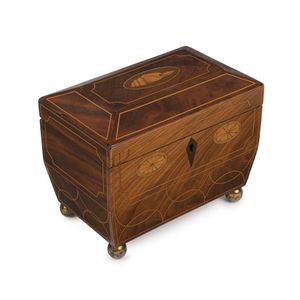George III Sheraton Tea Caddy from Blair Castle
You must be a subscriber, and be logged in to view price and dealer details.
Subscribe Now to view actual auction price for this item
When you subscribe, you have the option of setting the currency in which to display prices to $Au, $US, $NZ or Stg.
- Satinwood - Satinwood is a dense pale gold coloured timber that was imported into Britain in the second half of the 18th century, and early 19th centuries from the East Indies and the West Indies. The name derives from the satin-like surface sheen when the timber is polished.
It was used in the solid, as a veneer and in inlays. As well as furniture, satinwood was used for making musical instruments, barometers, boxes and clocks.
It will usually be found on only the very best quality objects, presumably because of of its cost at the time. - George Iii - George III (1738 - 1820) was King of Great Britain and Ireland from 1760 to 1820.
- Mahogany - Mahogany is a dense, close grained red-coloured timber from the West Indies and Central America. It was first imported into Europe in the the early 18th century and its use continued through the 19th century. It was popular for furniture making because of its strength, the wide boards available, the distinctive grain on some boards, termed flame mahogany and the rich warm colour of the timber when it was polished.. The "flame" was produced where a limb grew out from the trunk of the tree, and this timber was usually sliced into veneers for feature panels on doors, backs and cornices.
Some terms used to describe mahogany relate to the country from which it originally came, such as "Cuban" mahogany, "Honduras" mahogany etc. However unless the wood has been tested the names assigned are more a selling feature, rather than a true indication of the timber's origin.
This item has been included into following indexes:
- tea caddies, material
- tea caddies, period or age - Georgian 327
Visually similar items

Cellarette: English flame mahogany sarcophagus shaped wine cooler, circa 1840. Height 43 cm, width 76 cm, depth 49 cm.

19th century English rosewood work box, fitted interior, concealed jewellery drawer and brass handles. Approx 17 cm high, 41 cm wide, 26.5 cm deep

An Australian cedar and pine deed box inlaid with Aboriginal weapon motif, Queensland origin, 19th century, 20 cm high, 36 cm wide, 23.5 cm deep

A 19th century satinwood sarcophagus-shaped tea caddy, with three compartments to the interior, raised on bun feet.
